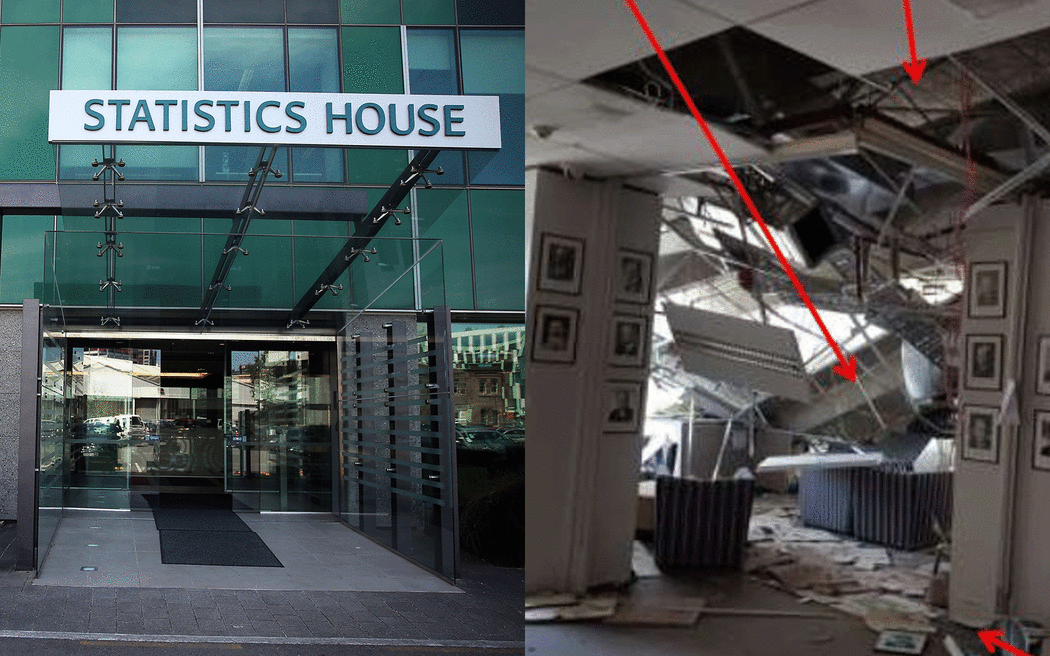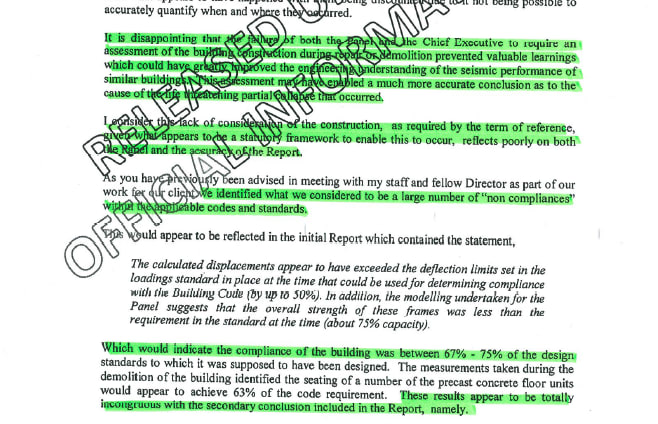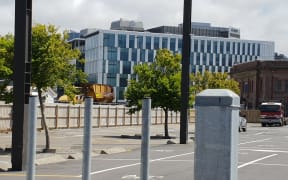The engineering firm that oversaw the demolition of Statistics House raised serious concerns about the findings of the inquiry into its partial collapse.

A 2013 photo of Wellington's Statistics House, left, with a photo of damage on the ground floor following the 14 November 2017 earthquake (from March 2017 inquiry report). Photo: RNZ / Supplied
Documents released under the Official Information Act also raise questions about how the only major government inquiry into the damage of a large building in the Kaikōura earthquake was run.
The Statistics House inquiry reported back in March this year; its findings have gone on to spur changes in how high-rise floors are constructed.
By then, the leading Wellington firm Spencer Holmes was already asking why the floors at the near-new waterfront building were collapsing so easily during the demolition.
It concluded, after measuring some, that the concrete nibs the floor beams sat on were far too narrow (40mm, versus 60mm in the standard, and 50-75mm in the building plans).
That finding led the the Ministry of Business, Innovation and Employment (MBIE) to restart the three-person independent inquiry panel.
But the panel's second report or addendum went on to discount the nibs as contributing to the failure, and stick by its original findings that focused on the floor beams.
"The panel have by and large discounted the items identified during the demolition which I find disappointing," a Spencer Holmes director, who is not identified, responded in a letter to MBIE in June.
There was a lot more evidence the nibs were too narrow than that the floor beam ends failed, the director said.
"Having personally witnessed the demolition of this building following what I consider to have been a life-threatening partial collapse, I consider this outcome in both the initial report and the addendum to be disappointing."

Photo: rnz / supplied
Five times, according to the OIA, Spencer Holmes told MBIE what had gone on was "disappointing".
The narrow nibs indicated problems with construction, the firms said, and it had told MBIE about others.
"We identified what we considered to be a large number of non compliances," the director's letter said.
In fact, the inquiry panel's first report indicated something similar: that the design was only 67 to 75 percent up to standard - but concluded that none of this was relevant to the partial collapse.
The panel also concluded Stats House was "otherwise generally designed and constructed in accordance" with the Building Code.
These statements were "totally incongruous", Spencer Holmes told MBIE.
"I would have thought a somewhat higher level of compliance would have been required so as to achieve general compliance with the Building Code," its director wrote.
The panel had allowed a major omission by not checking during demolition whether the construction matched the design.
This went against its terms of reference, and meant a real-life lesson in how quakes damage buildings had been diluted.
"It is disappointing that the failure of both panel and the [MBIE] chief executive to require an assessment of the building construction during ... demolition prevented valuable learnings which could have greatly improved the engineering understanding of the seismic performance of similar buildings," said Spencer Holmes.
"This assessment may have enabled a much more accurate conclusion as to the cause of the life-threatening partial collapse that occurred.

Photo: RNZ /SUPPLIED
The director added: "I consider this ... reflects poorly on both the panel and the accuracy of the report."
Elsewhere in the OIA, the engineering firm that did the construction monitoring admitted the narrowness of the floor nibs was missed.
"The reduced seating had not been picked up by site QA [quality assurance]," Dunning Thornton, which also designed Statistics House, said in January 2018.
It listed three ways to fix this, including to "reinforce to all engineers the importance of checking seatings during floor pours (which typically otherwise are not technically complex)".
Dunning Thornton told RNZ to direct our questions to MBIE.
One of the three-person panel contacted, structural engineer John Hare, said the same. RNZ did not hear back from the other two.
MBIE in a statement said the inquiry panel fulfilled the scope in the terms of reference and consulted over the design, construction and demolition of the building.
"MBIE has full confidence in all panel members and in the process that the panel followed," said Dave Robson, manager of building performance and engineering.
Spencer Holmes declined an interview.
An OIA released to RNZ earlier this month showed Spencer Holmes had also raised serious questions about the design of BNZ Harbour Quays - it was built next to Statistics House, and will follow Stats House in being demolished soon due to damage from the Kaikōura quake.



